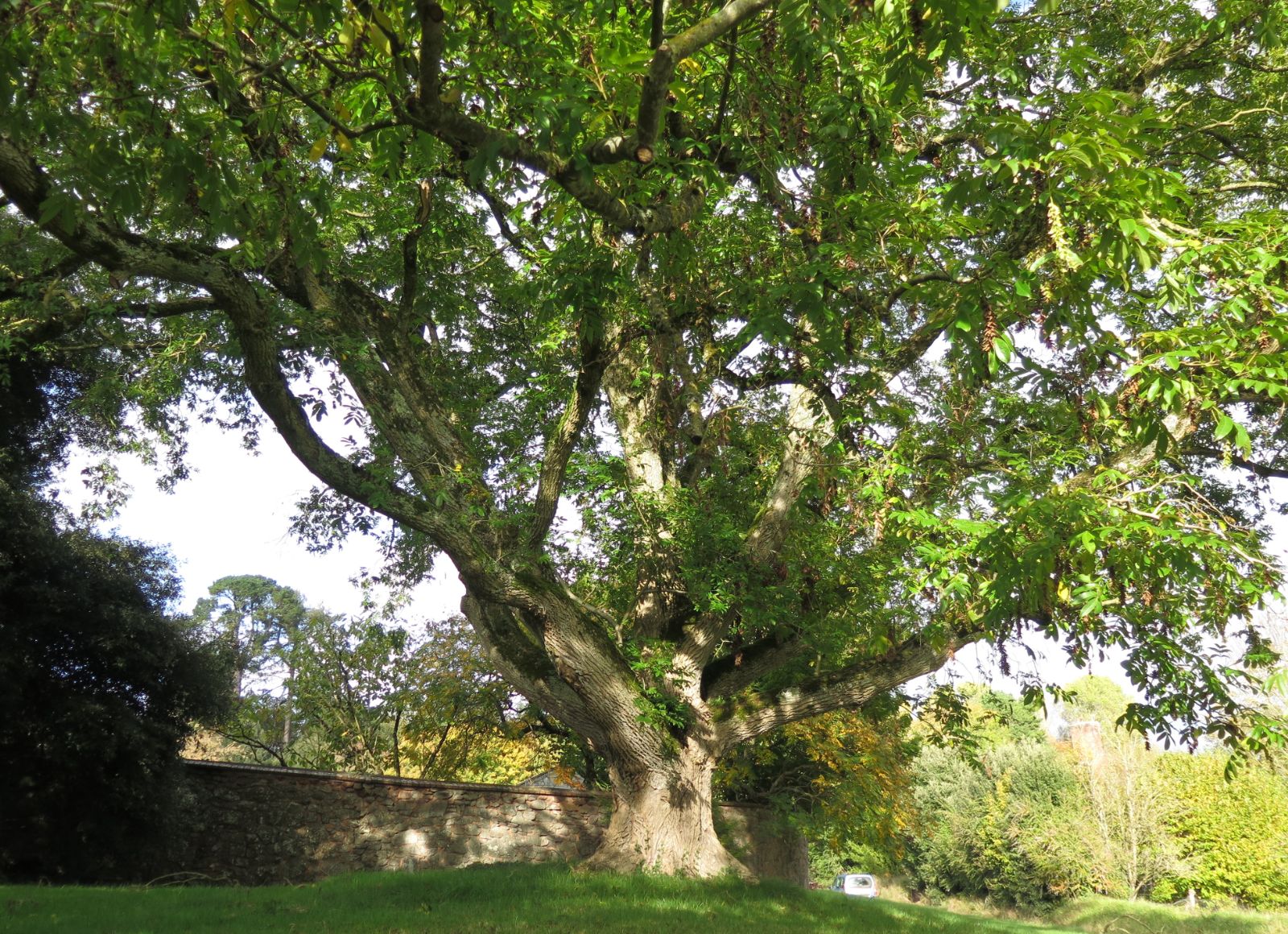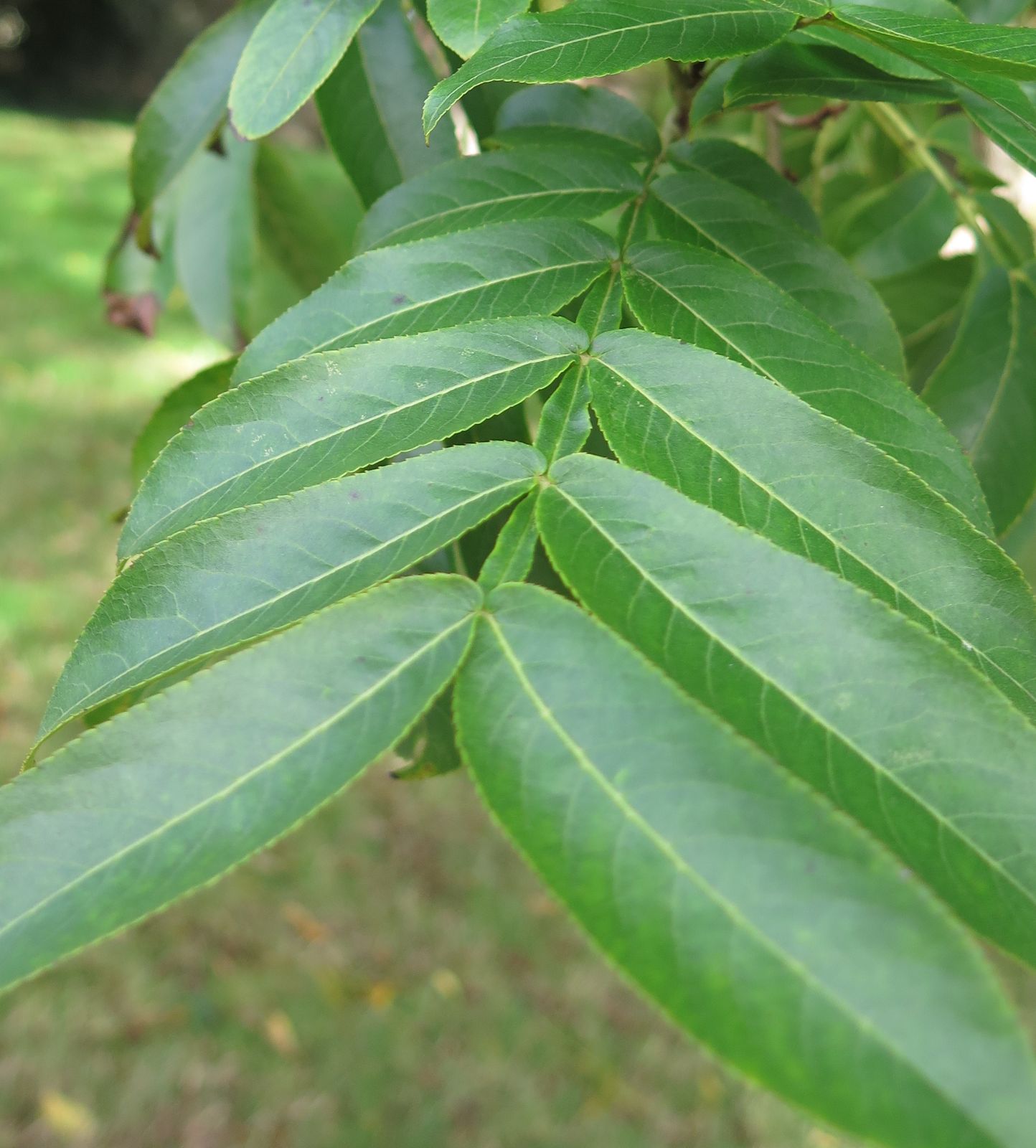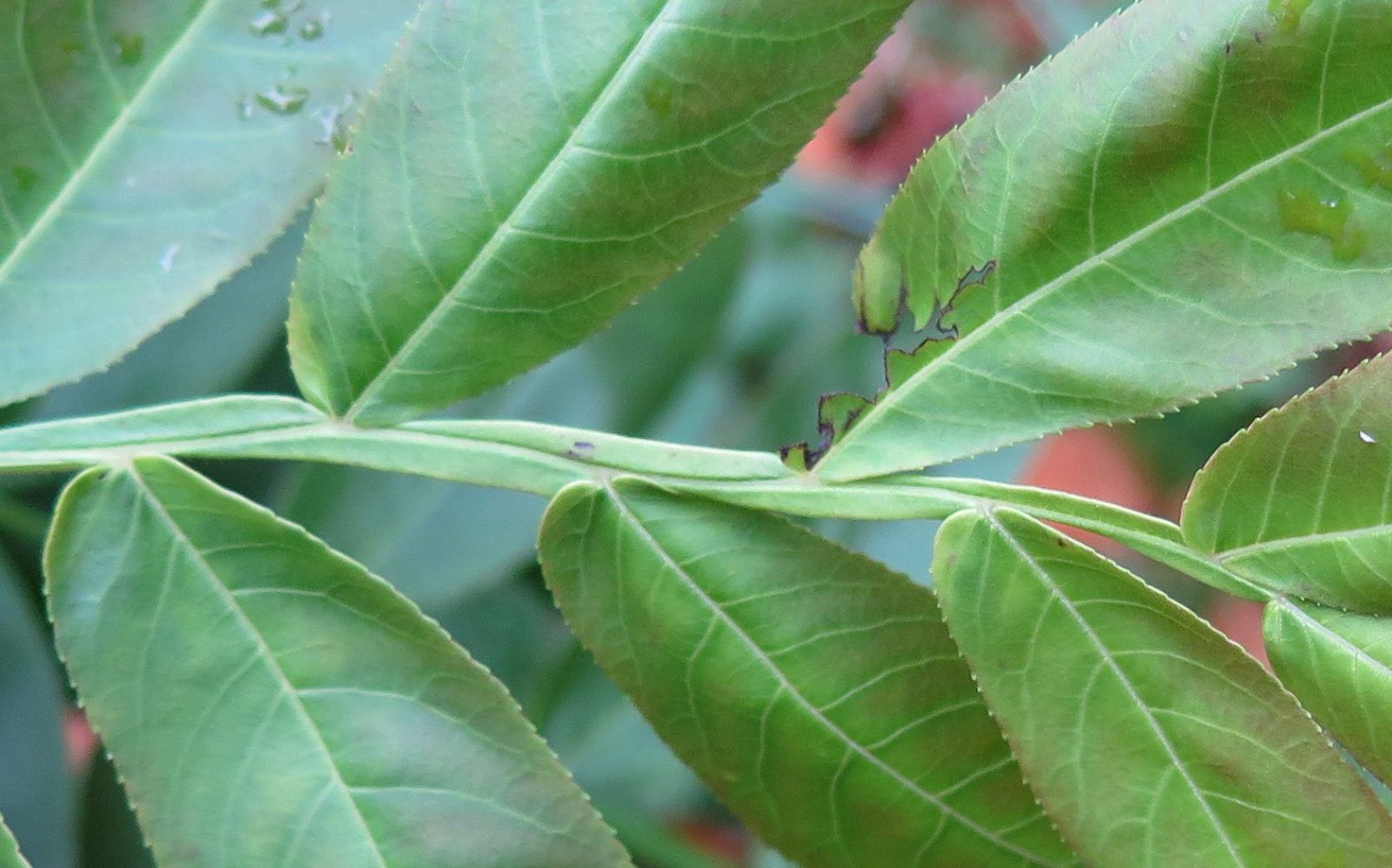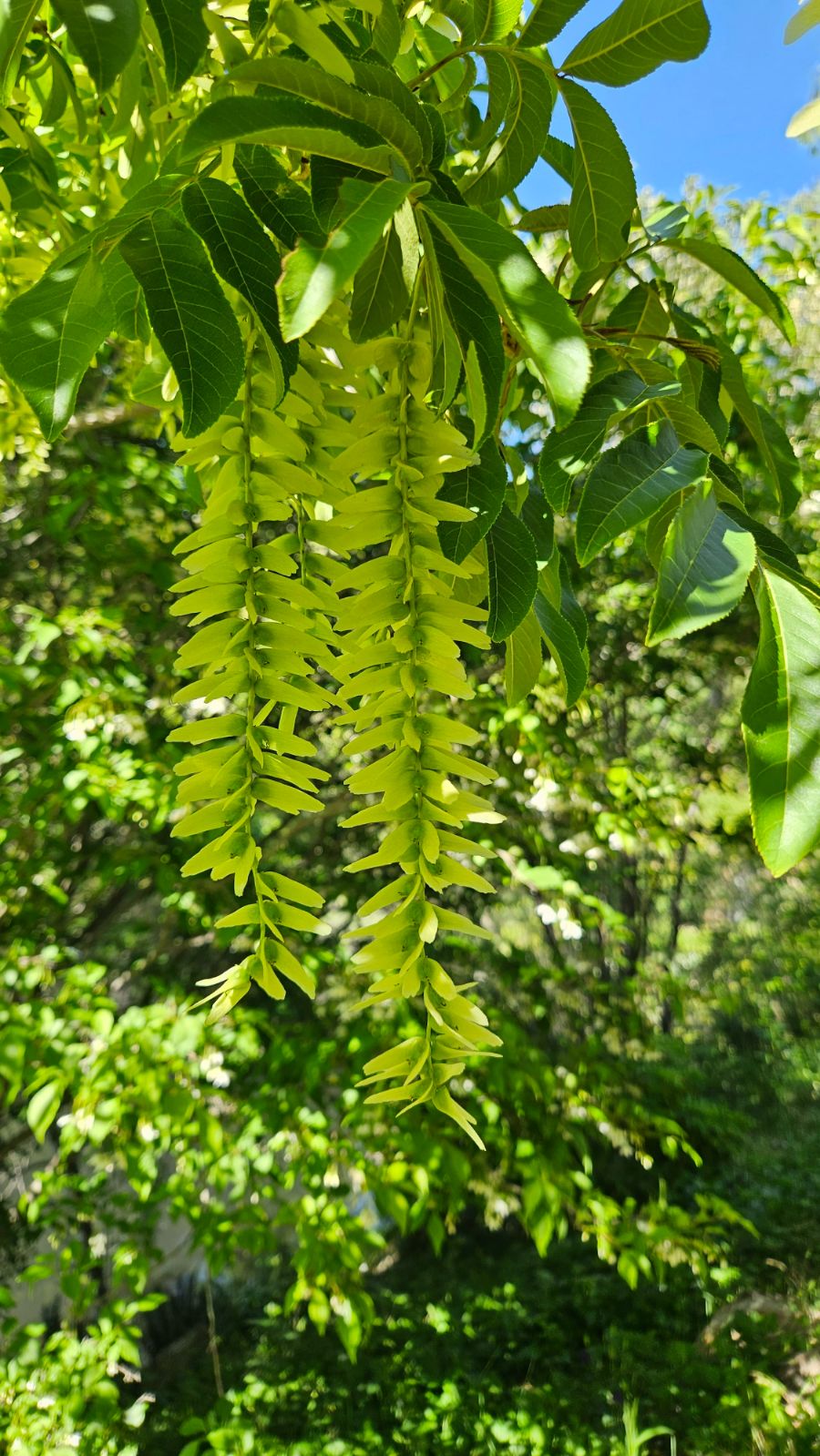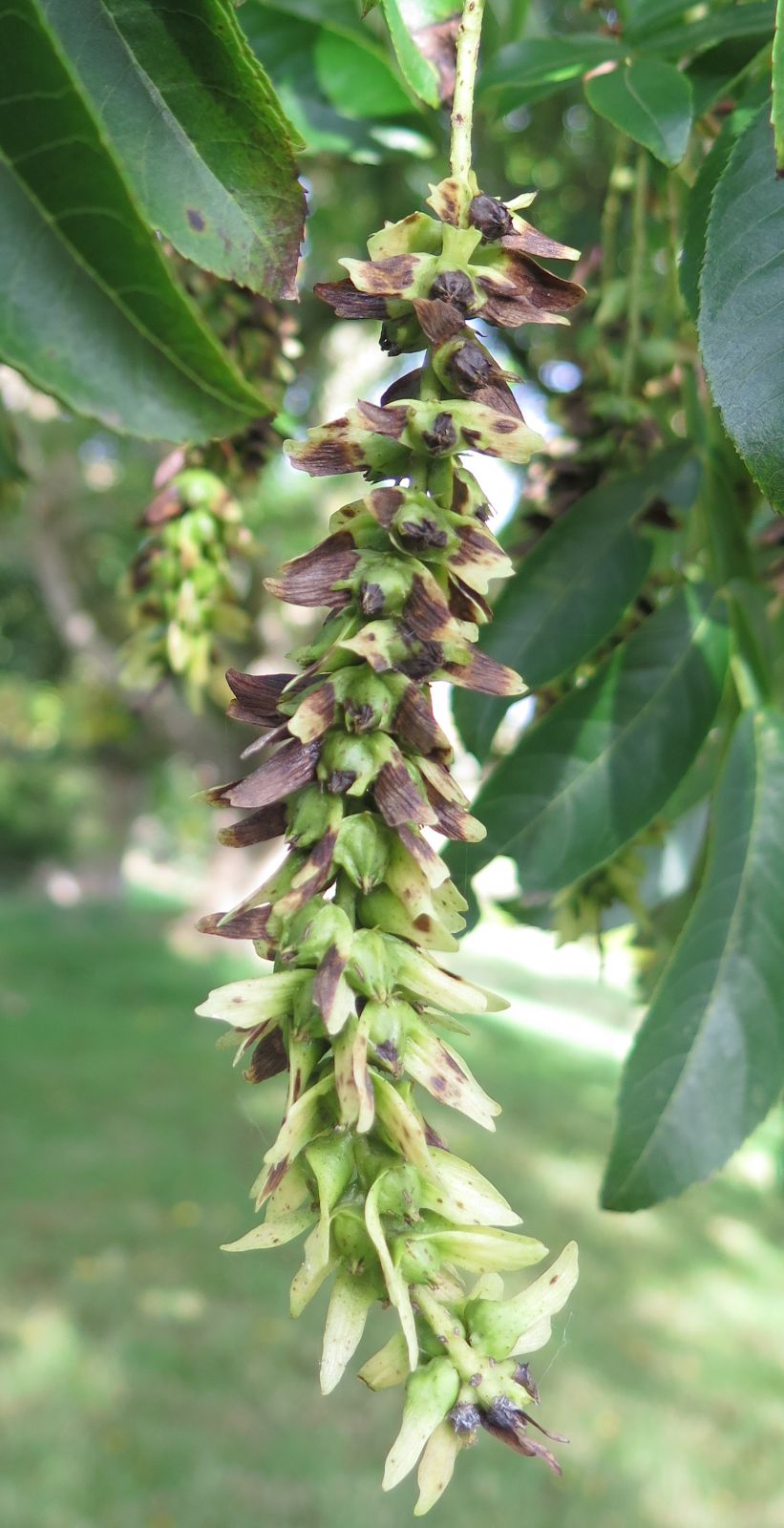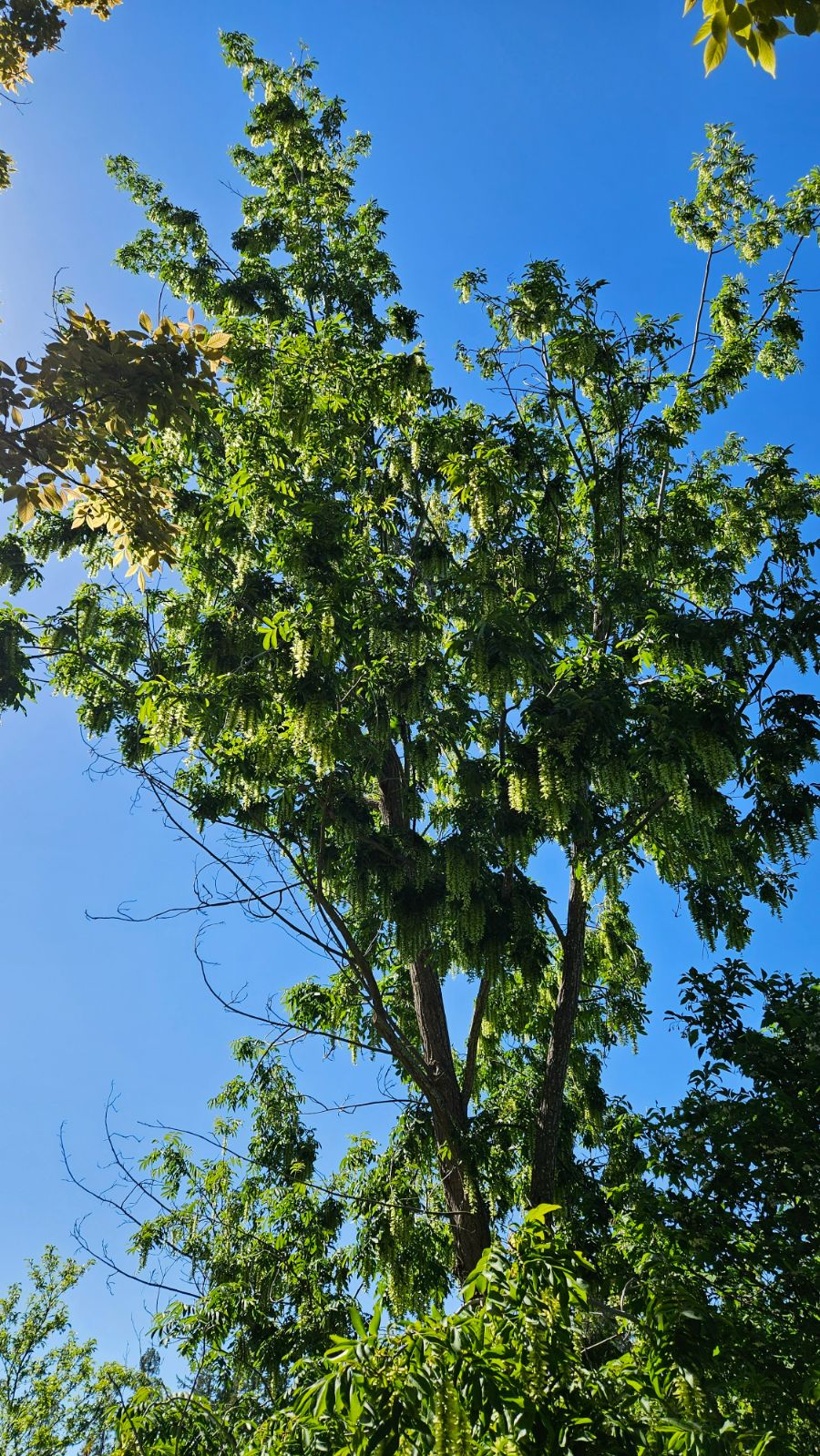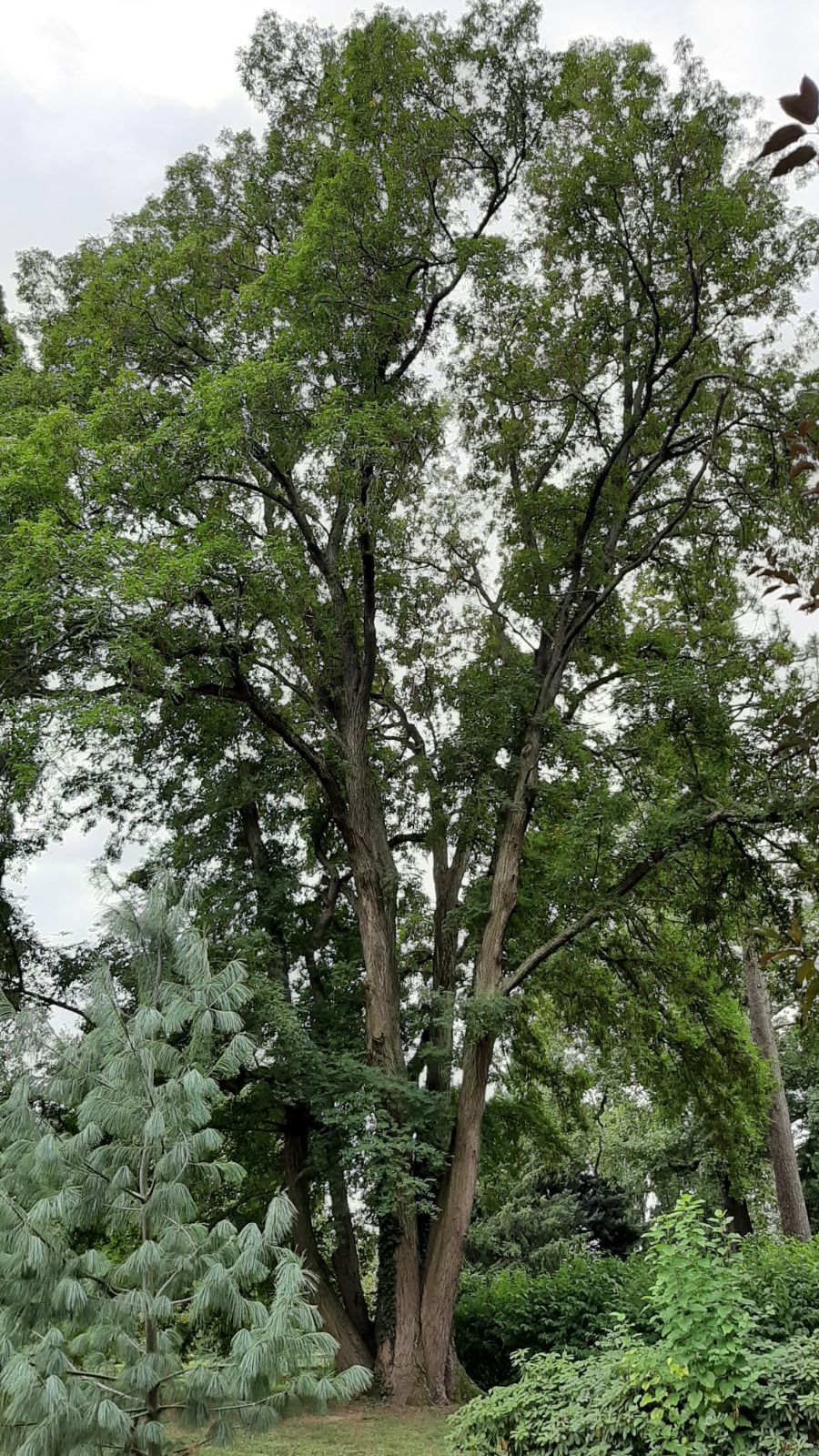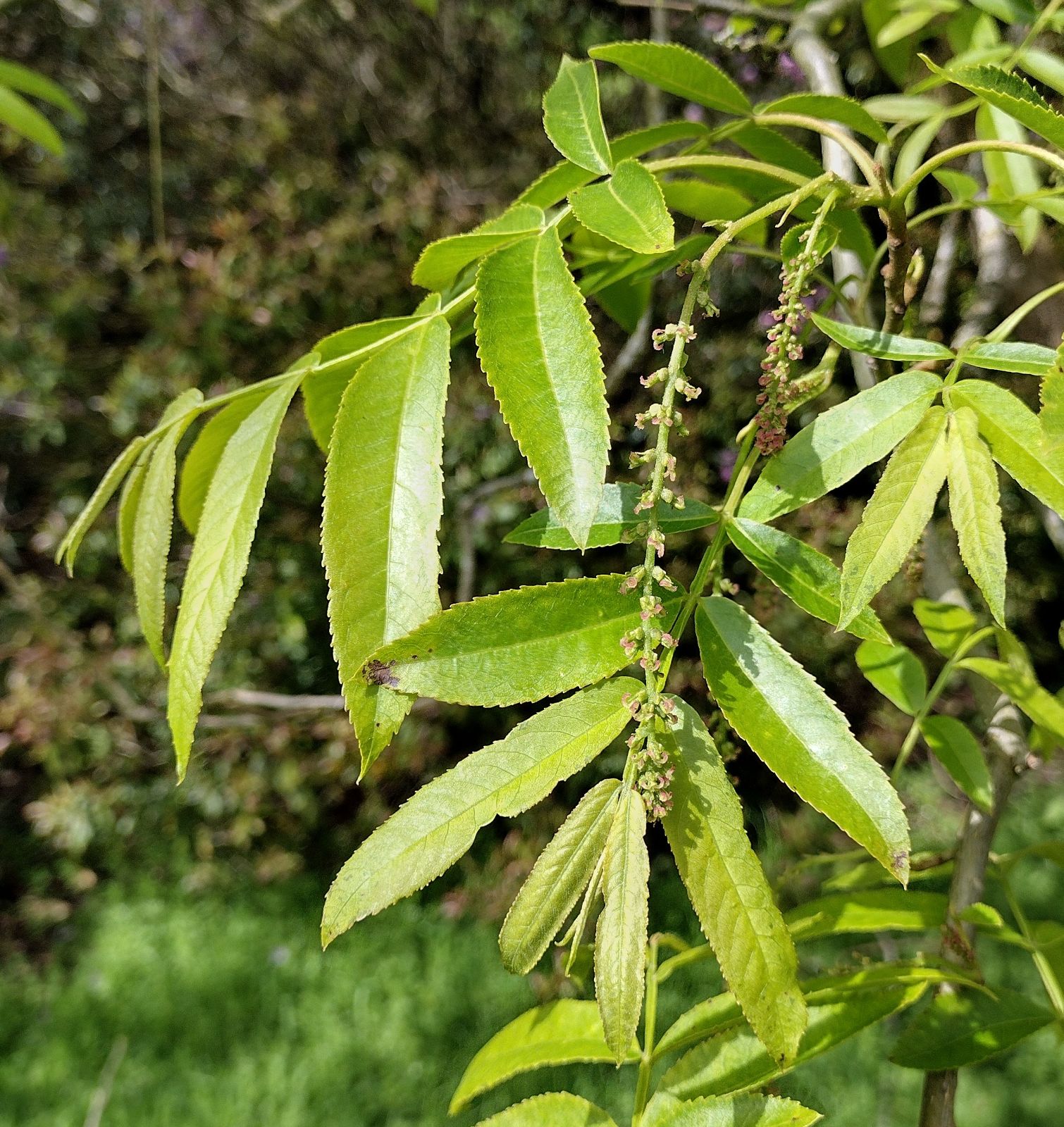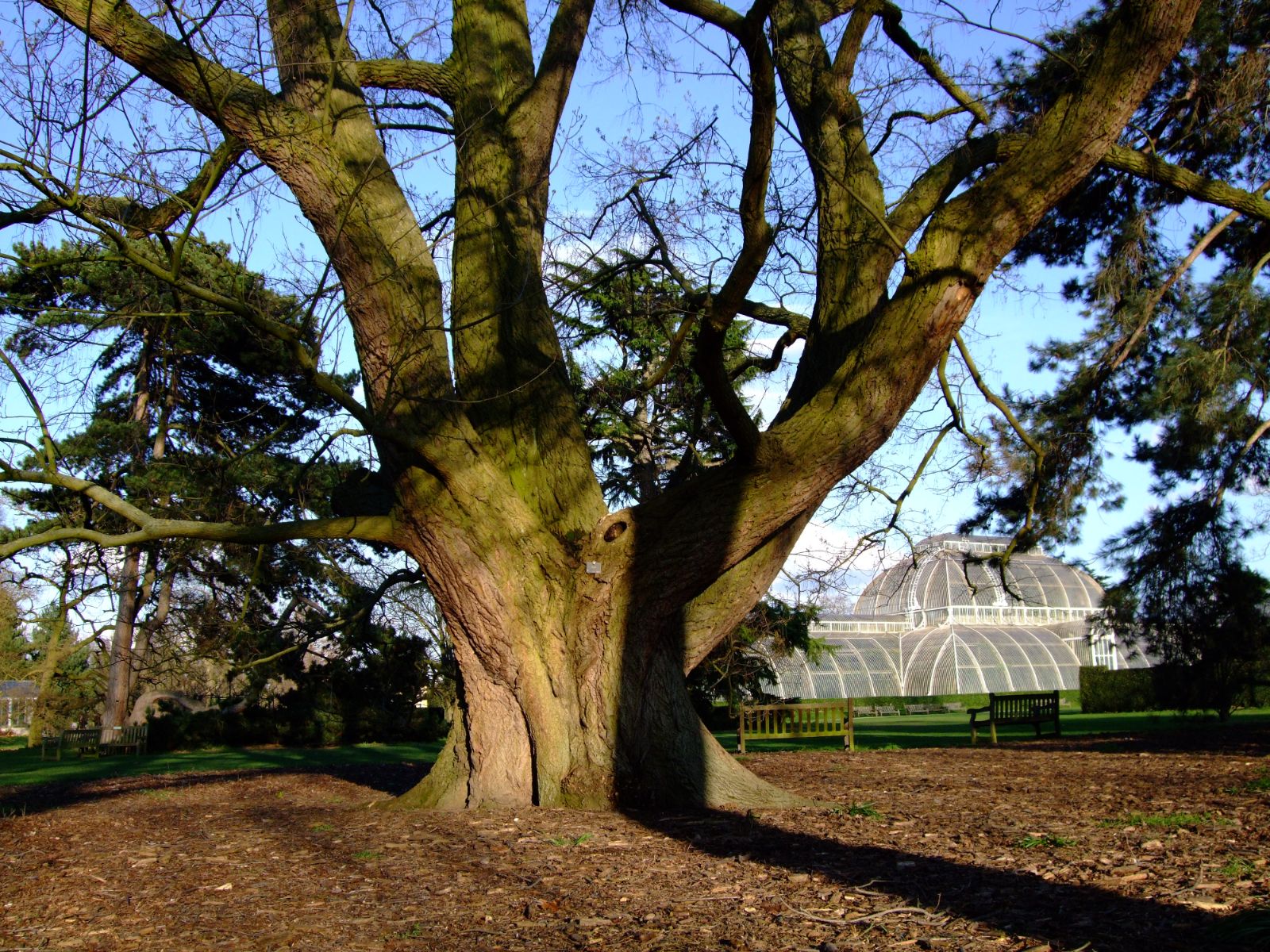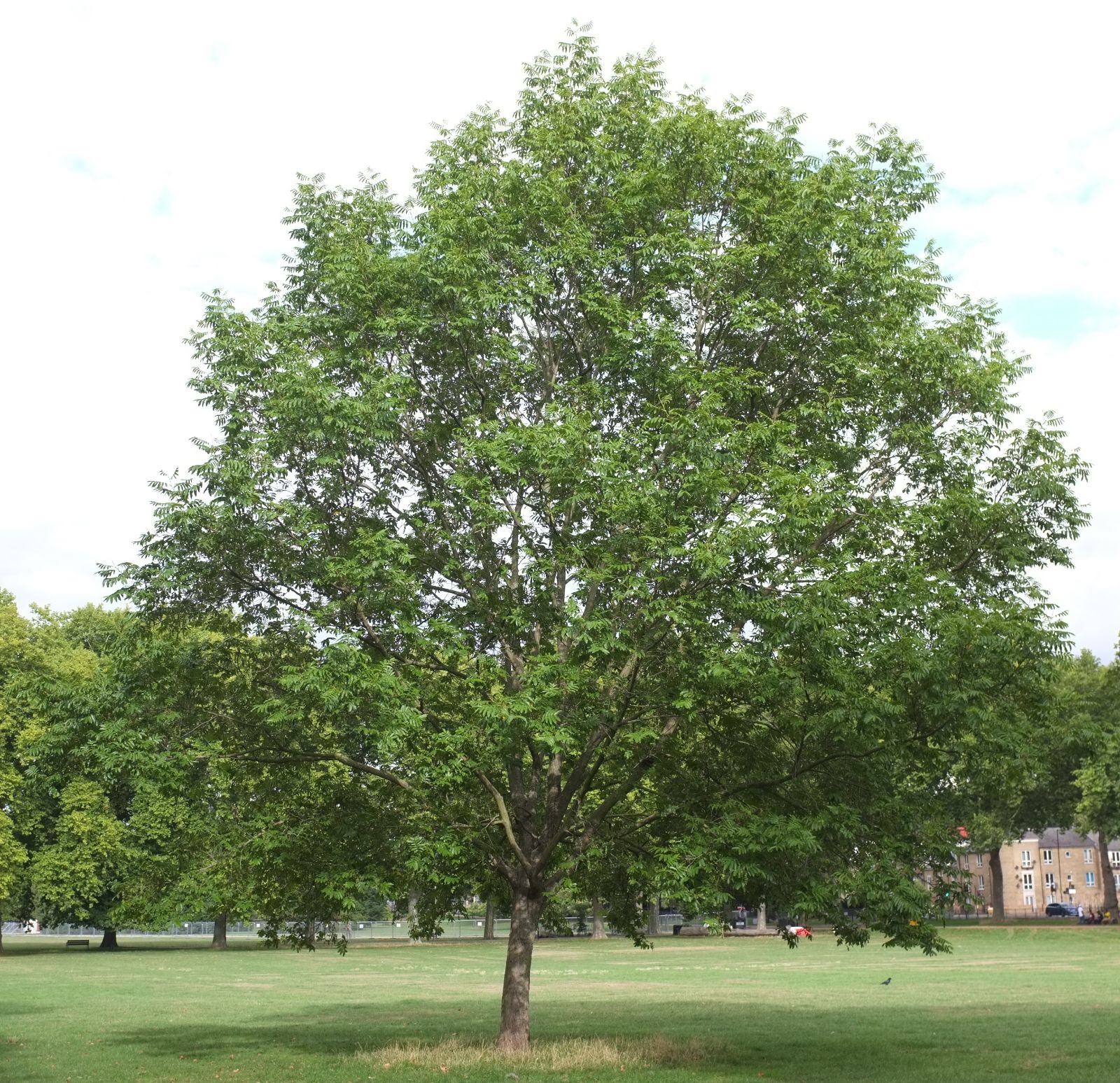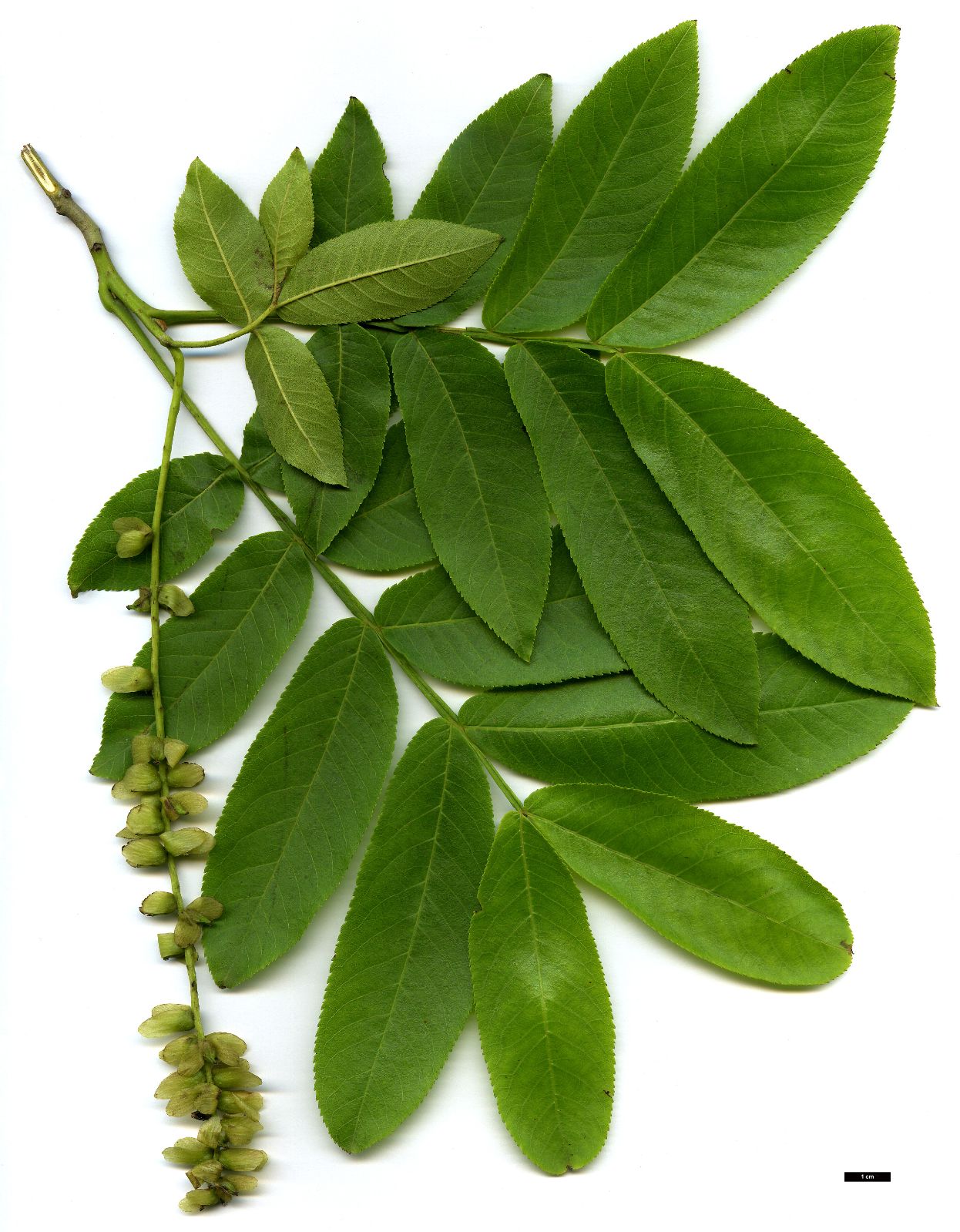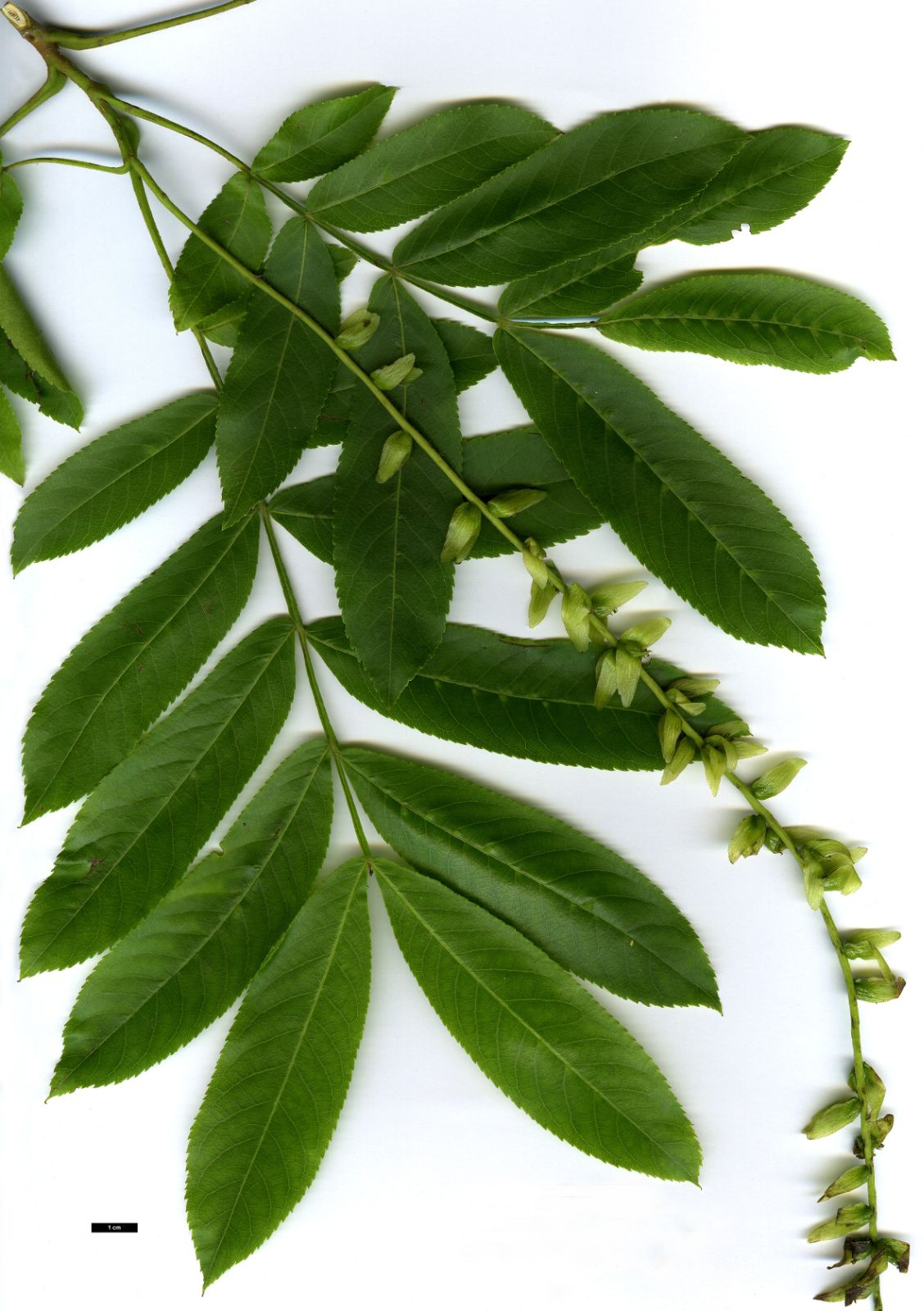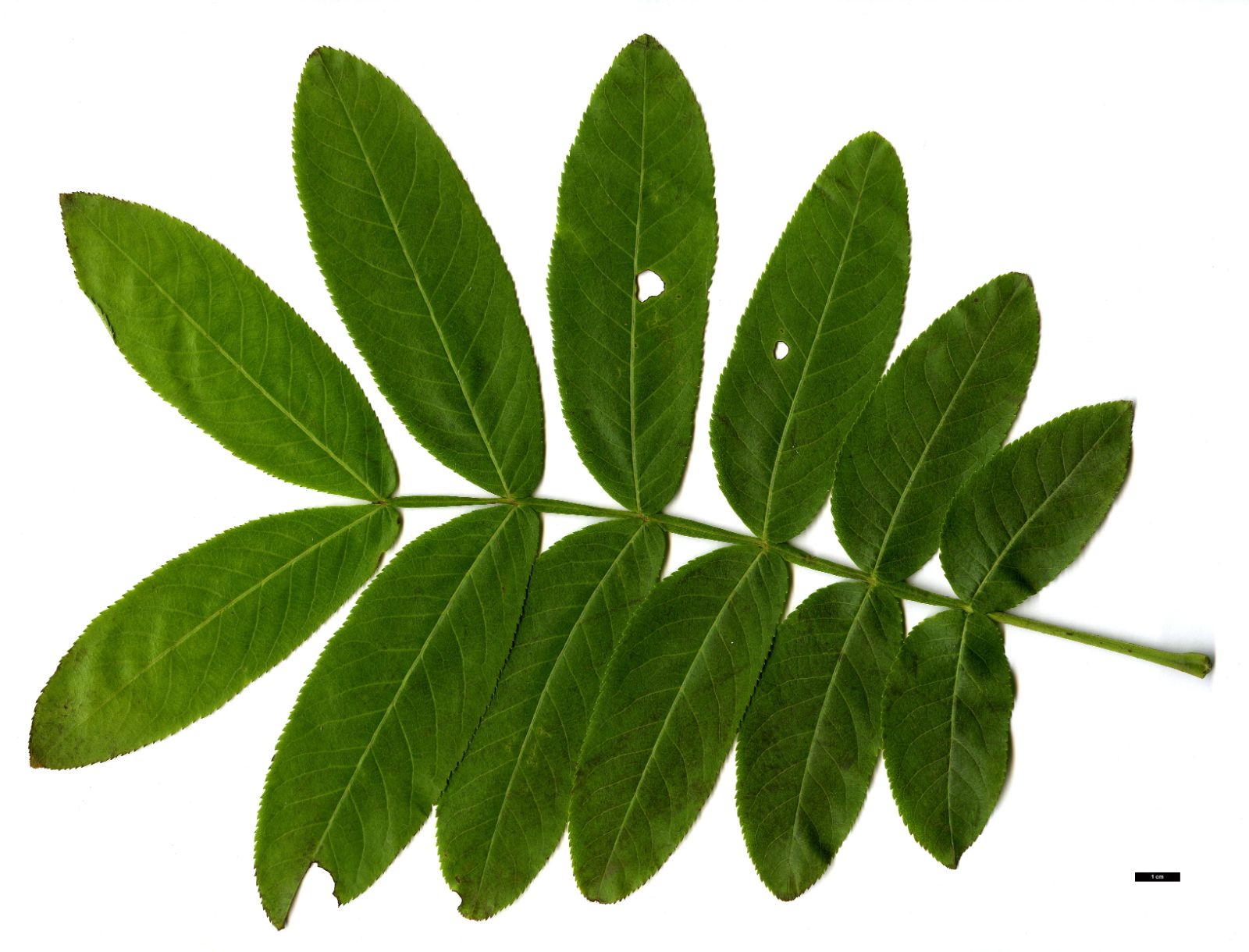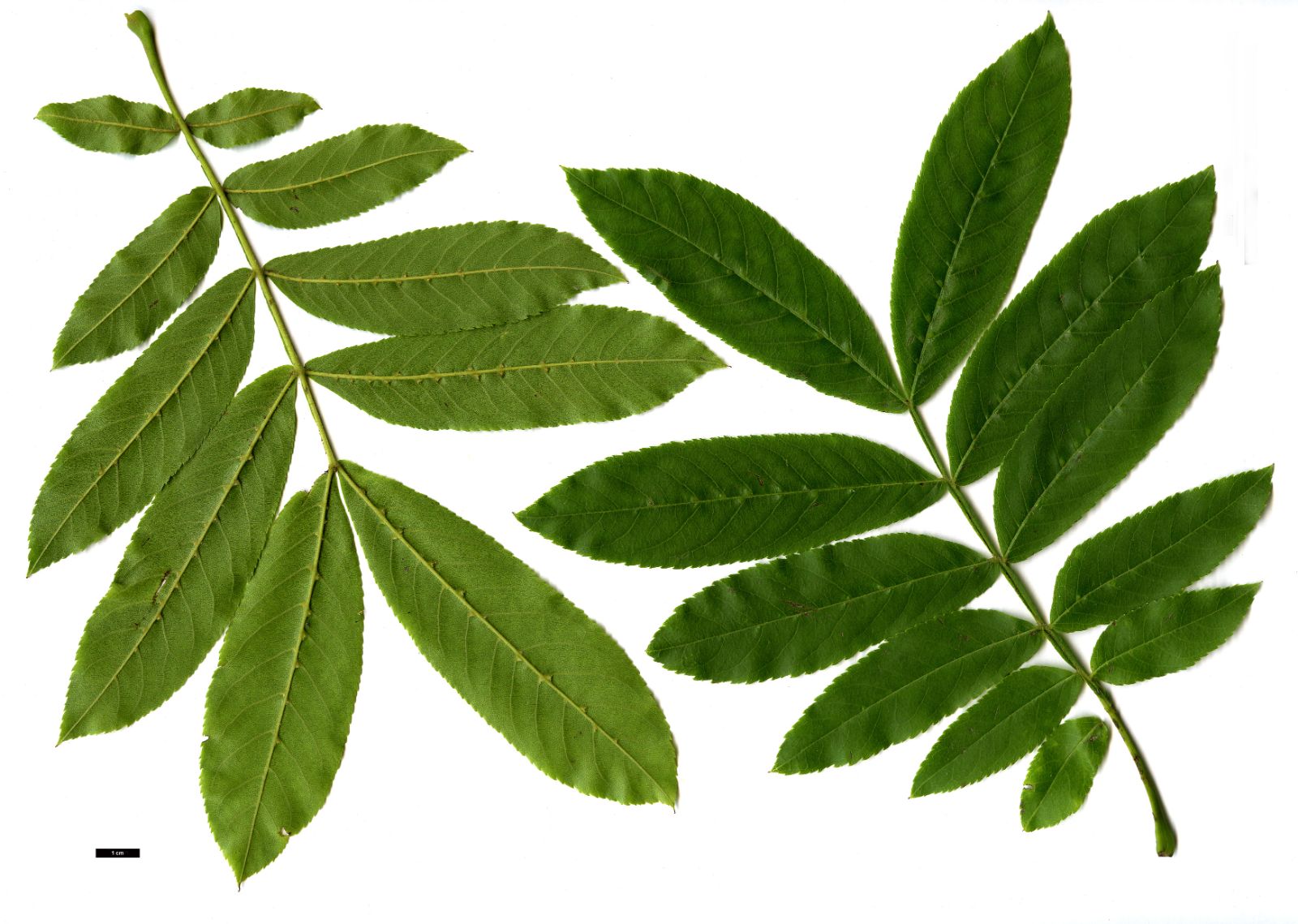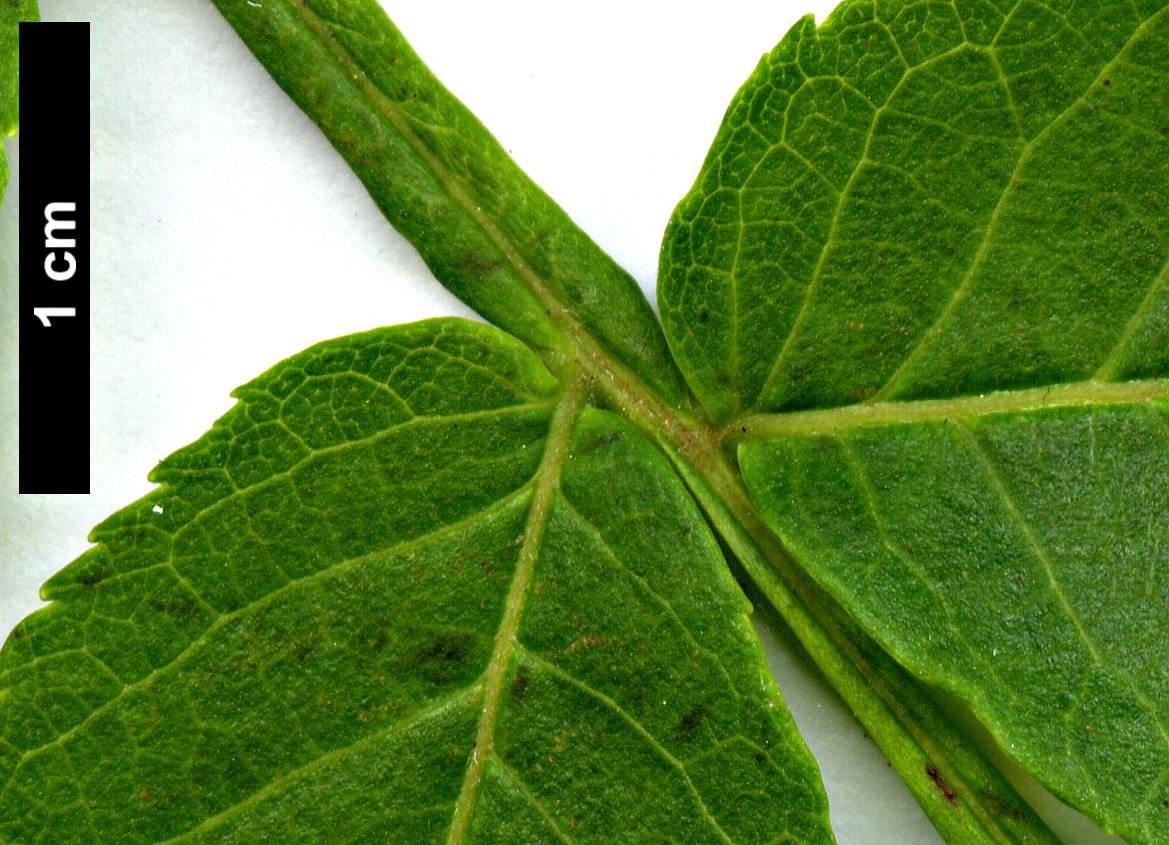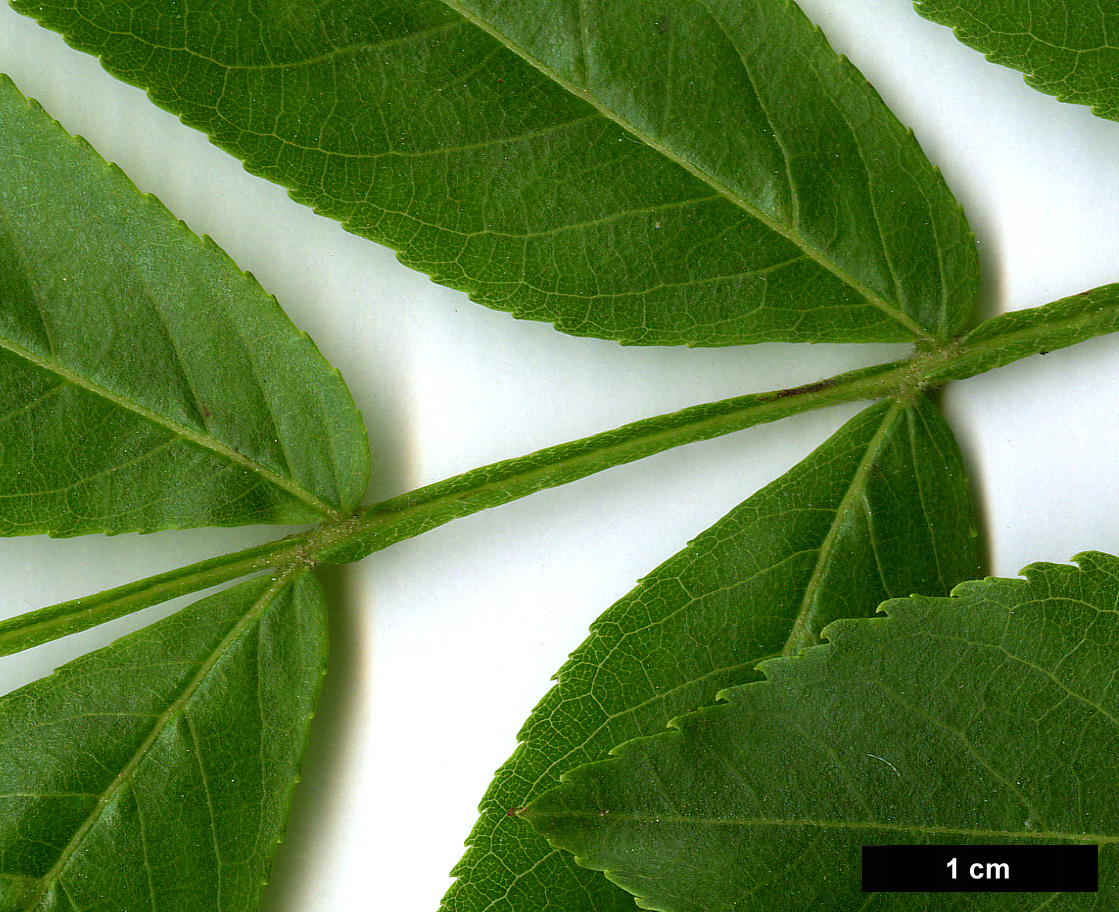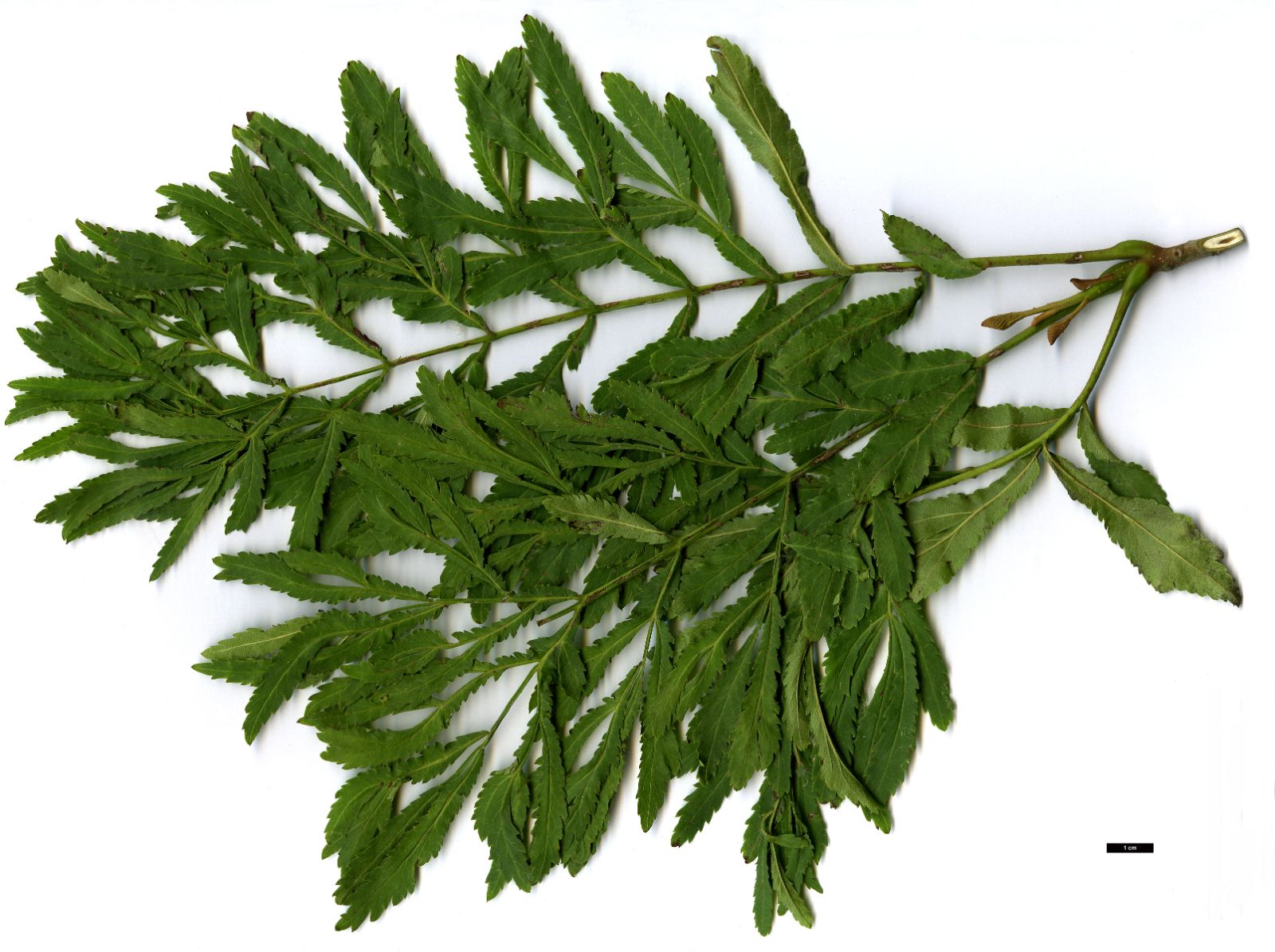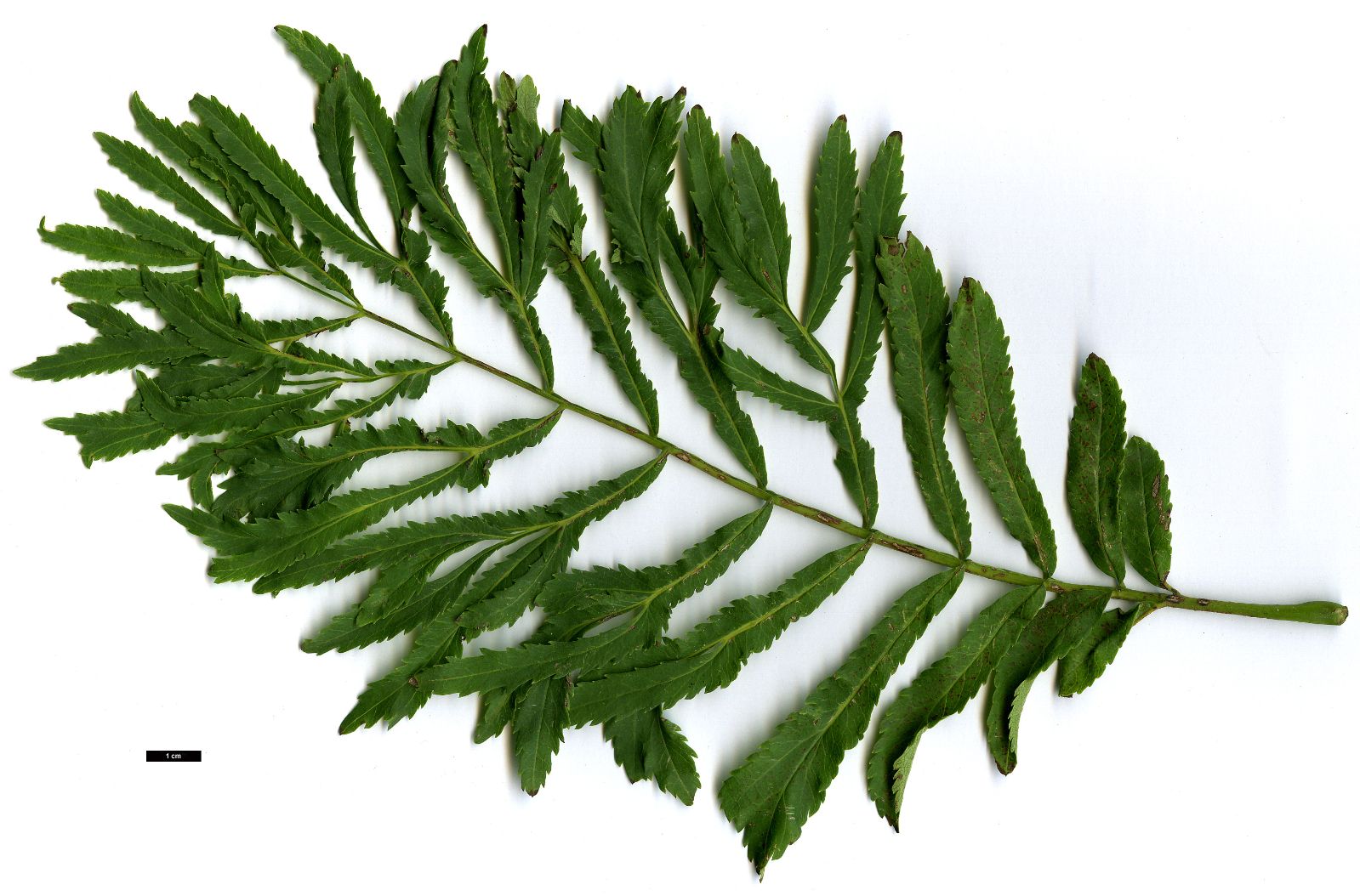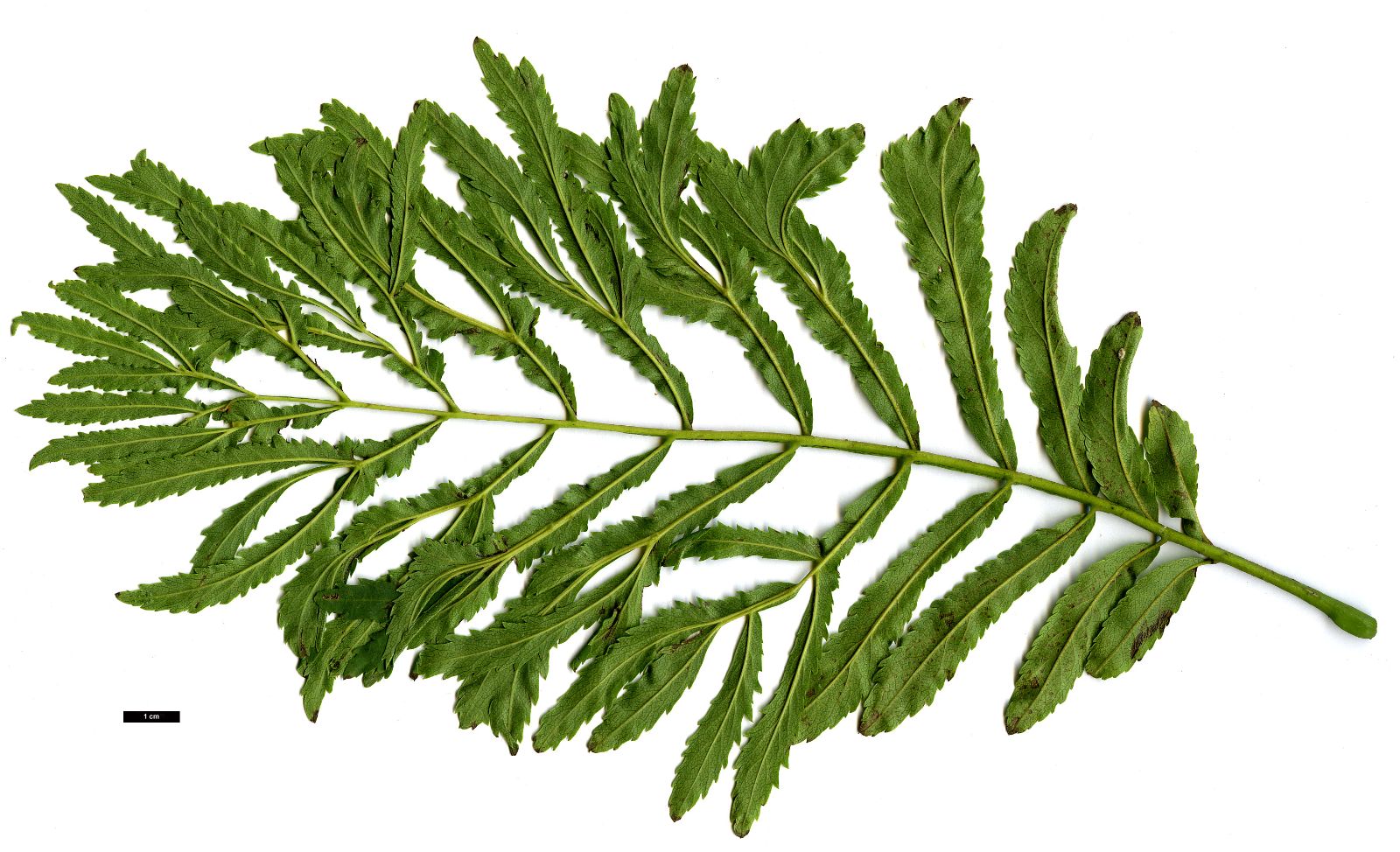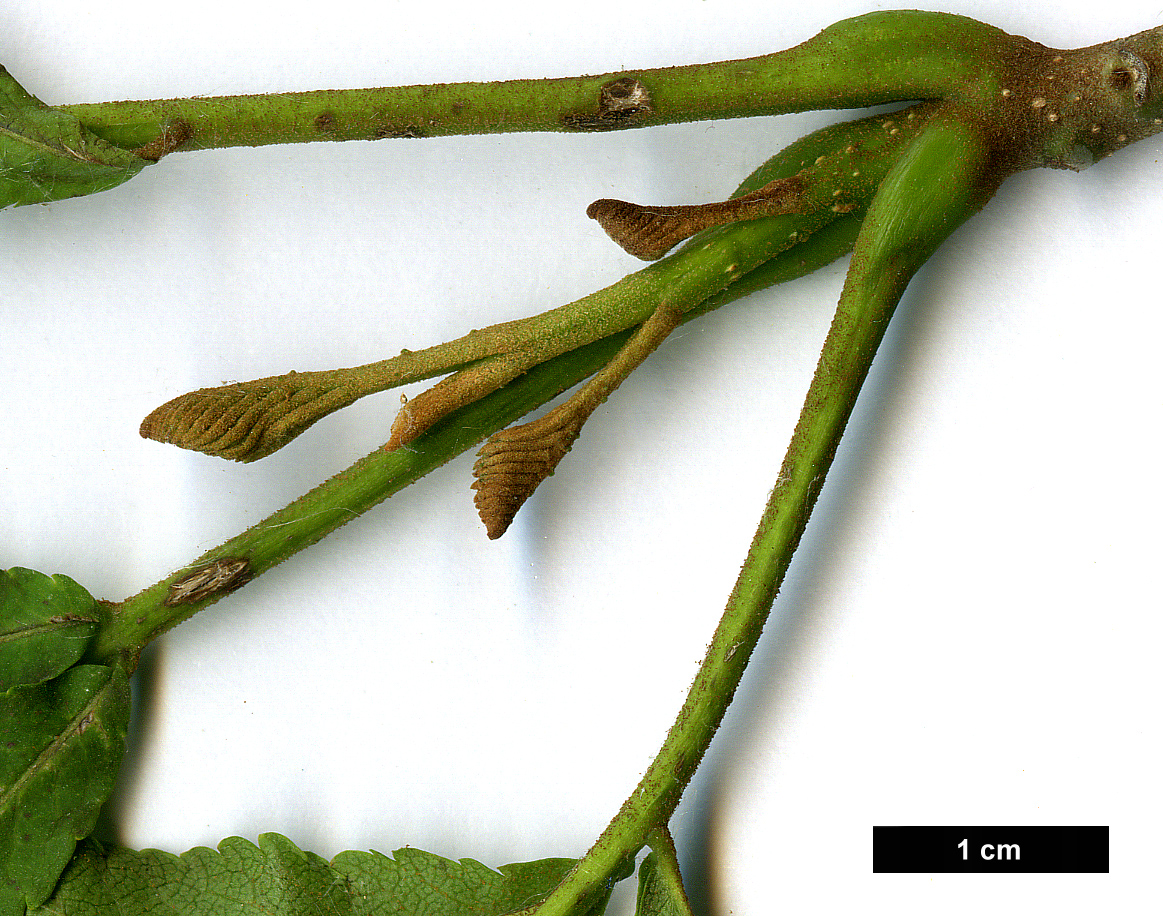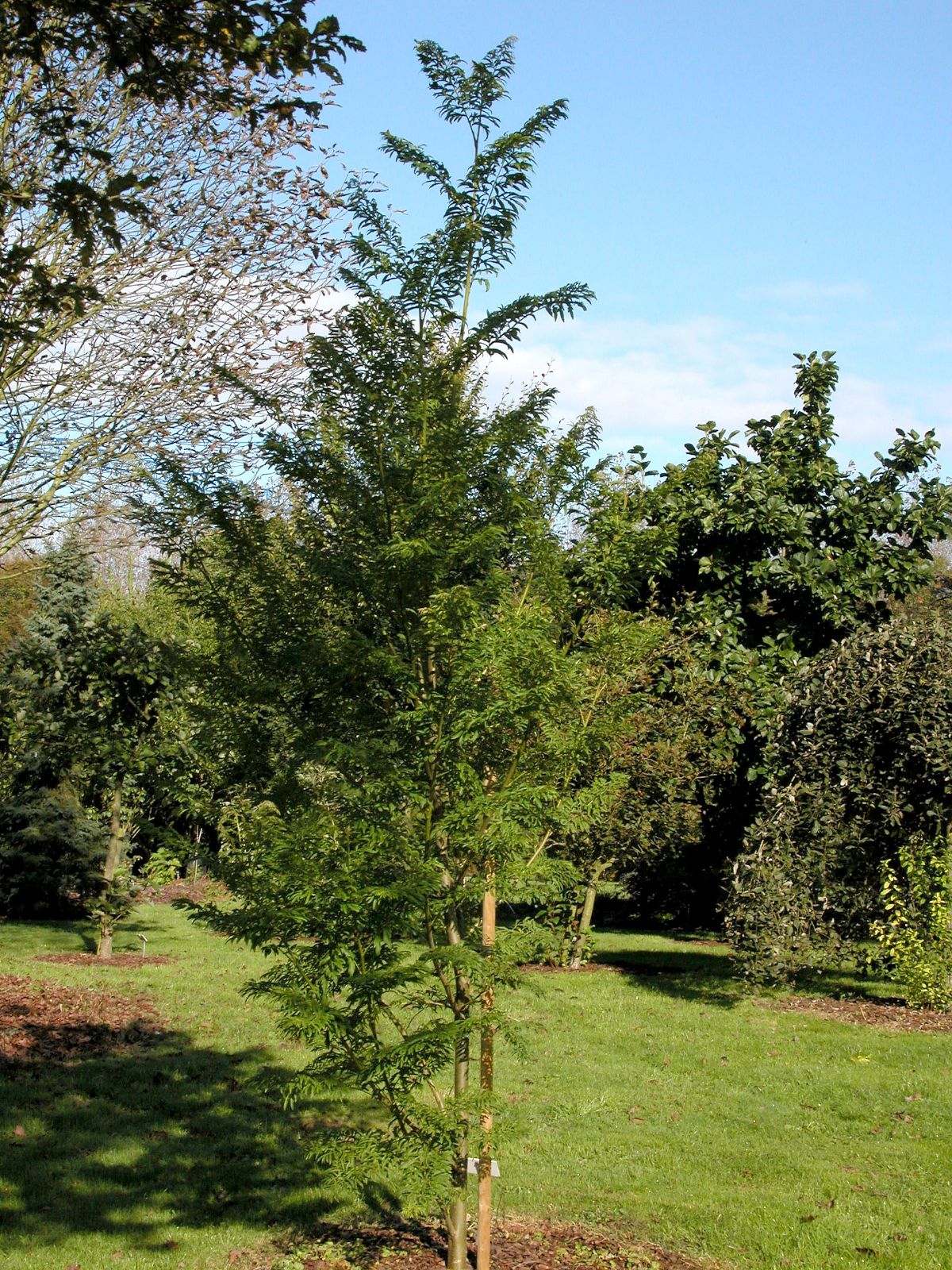Pterocarya stenoptera
Sponsor
Kindly sponsored by
a member of the International Dendrology Society
Credits
Julian Sutton (2019)
Recommended citation
Sutton, J. (2019), 'Pterocarya stenoptera' from the website Trees and Shrubs Online (treesandshrubsonline.
Genus
Common Names
- Chinese Wingnut
- feng yan
Large tree to 30 × 2 m with grey bark, smooth when young, becoming deeply fissured. Crown often broad, suckering freely from the roots. Branchlets pubescent or glabrous, terminal buds naked. Leaves paripinnate, rarely imparipinnate, 8–16(–25) cm, rachis often winged (rarely only ridged or sulcate). Leaflets (6–)11–21(–25), sessile, long elliptic to elliptic-lanceolate, 8–12 × 2–3 cm, slightly pubescent beneath, base oblique, cuneate or broadly cuneate, apex obtuse or acute, margin serrate. Petiole 2–6.5 cm. Male catkins narrow, to 8 cm, female catkins 20–45 cm. Nutlets long ellipsoid, 6–7 mm in diameter; wings linear, 1.2–2.5 × 3–6 mm. Flowers April–May, fruiting August–September (China). (Lu et al. 1999; Kozlowski et al. 2018).
Distribution China Anhui, Fujian, Gansu, Guangdong, Guangxi, Guizhou, Hainan, Hebei, Henan, Hubei, Hunan, Jiangsu, Jiangxi, Liaoning, Shaanxi, Shandong, Shanxi, Sichuan, Yunnan, Zhejiang Vietnam North East Taiwan
Habitat Forests on mountain slopes or riverbanks; near sea level to 1500 m.
USDA Hardiness Zone 6-8
RHS Hardiness Rating H5
Conservation status Not evaluated (NE)
This is the most widely distributed of the wingnuts, and also one of the more widely tested in cultivation. Native across much of China, it tends to be found in the lower reaches of river systems, unlike most other Pterocarya species (Kozlowski et al. 2018). Its natural East Asian range is considerably expanded within and beyond China through its widespread planting as a shade tree (Lu et al. 1999). It is easily recognised by the winged rachis of the pinnate leaves, and the narrow nut wings. This last character gives rise to the specific epithet, from the Greek stenos (narrow) and pteron (wing or feather).
Pterocarya stenoptera was first known to Western science through specimens sent to France in 1844 by the French-Italian missionary naturalist Joseph Callery (Bean 1976). The name was not published until 1862, however, by which time living material sent by the German-born doctor and botanist Phillip von Siebold, presumably from Japanese cultivation, had reached Holland in 1860 (Jacobson 1996). Material sent by the American missionary R.H. Graves, who was stationed in Canton (now Guangzhou) between 1856 and 1912 (Powers 1931) was another early introduction (Anderson 1933).
Large, mature specimens are found in gardens scattered across the British Isles. A broad crowned, low branching, heavily built specimen at RBG Kew was measured at 22 m × 156 cm in 2010, whilst one planted at RBG Edinburgh in 1951 had reached 18 m × 64 cm in 2014. In Ireland a specimen at Birr Castle, Co. Offaly measured 23 m × 94 cm in 2014 (The Tree Register 2019). An old (1902) and once magnificent tree at Dyffryn Gardens, South Wales, sometimes mentioned in the literature, is now much reduced following storm damage and pollarding (The Tree Register 2019). Significant trees are found across Europe as far east as Slovakia and south to Northern Italy. It seems likely that faster growth rates in the warmer summers of more continental parts of Europe result in taller trees. For example, a specimen at the Neuer Tiergarten Kleve, Germany was measured at 27 m in 2014 (monumentaltrees.com 2019). P. stenoptera has been grown since 1999 as far north as southern Finland at the Arboretum Mustila, where it seems less susceptible to late frosts than other species (Arboretum Mustila 2019).
The Chinese Wingnut had reached North America by 1896 and was available in the nursery trade by 1920 (Jacobson 1996). Arboretum records taken together give a picture of a tree hardy in the US to the east of the Appalachian chain and to the west of the Cascades – Sierra Nevada axis. Examples include specimens at: the Arnold Arboretum, MA (although in the past Rehder (1903) considered it tender there), the US National Arboretum, Washington D.C., UC Berkeley, CA and Washington Park Arboretum, WA (Arnold Arboretum 2019, US National Arboretum 2019, University of California Botanical Garden 2019, University of Washington Botanic Gardens 2019). Tall specimens are found on both seaboards, Jacobson (1996) reporting 27 m in Philadelphia, PA and 23 m at Berkeley. A collection made in Hubei by the Sino-American Botanical Expedition in 1980 (SABE 1573) is a major source of younger material in American collections. Pterocarya stenoptera seems unlikely to thrive long-term in central North America.
In its favour, this is a handsome tree, tolerant of wet ground, clay and compaction, which in moist, warm-summer climates can grow very fast: Gilman & Watson (1994) describe a specimen in Raleigh, NC, reaching 7.5 m × 36 cm in six years. On the minus side, in a genus prone to suckering this species is one of the worst culprits. Annual – or even more frequent – removal of suckers is advisable; planting close to asphalt or concrete is risky, due both to suckering and to the shallow roots (Gilman & Watson 1994). It would also seem prudent to avoid land drains and the foundations of buildings. It can be very late to drop its leaves: a specimen at Colesbourne Park, Gloucestershire, (growing in very thin soil over limestone brash) usually drops its leaves (by then black) in December, necessitating careful raking to avoid damage to emerging Galanthus shoots, annually irritating the gardening staff (J. Grimshaw, pers. comm. 2019).
P. stenoptera hybridises with P. fraxinifolia to give the fertile P. × rehderiana. For a discussion of identification problems, see P. × rehderiana.
'Fern Leaf'
RHS Hardiness Rating: H6
An exceptionally handsome, vigorous clone with pinnate or at least deeply toothed leaflets. Sometimes leaves may even be tripinnate (Pan-Global Plants 2019). The feathery, dark green leaves are unique and curiously fern-like. They can exceed 50 cm long on vigorous long shoots, though on mature branches they are smaller. John Grimshaw (Grimshaw & Bayton 2009; pers comm. 2019) experimented with stooling it annually at Colesbourne, Gloucestershire, to give a foliage plant for the border. For a while this was a success, extremely long leaves giving a beautiful effect, but the plant died after a few years, cause unknown. ‘Fern Leaf’ originated as a chance seedling in a batch raised by Geoff Locke of Mount Pleasant Trees, Rockhampton, Gloucestershire, in the early 1980s (G. Locke, pers. comm. 2008). This cultivar produces abundant suckers, providing a ready means of casual propagation.

